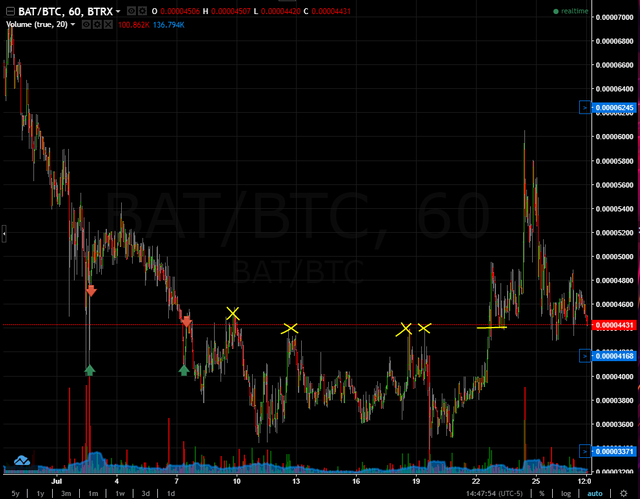You are viewing a single comment's thread from:
RE: Introducing our first Crypto Market Scanner
Luc,
I'm sorry you're getting overwhelmed with questions. If you can't get to it, maybe others can chime in on my question. I've been following along and getting pretty good at finding bases. I'm not as good - yet- at knowing when to buy based on the bases. I usually buy too soon. Here's my question. When a base is cracked just a little bit and then it jumps back up, does that nullify that base? The little jump-up doesn't make a good new base, so do I go back to the original base or wait for a new base with a big jump to form. Here's a chart to illustrate what I'm thinking: 
Thanks for sharing your knowledge!
I dont want to confuse anyone with all the Xs on this chart but lets talk about crowd mentality for a second. So 44s were resistance quite a few times, shown by the Xs and then when it finally broke threw it jumped up to 49s, then a sharp pullback to 44s again to see if that was going to hold as support, or in our language, was there a base forming at 44s.. then you get this huge spike to 60, and after all the craziness is over it starts to work its way back to the base and retest it a bunch of times.. bearly breaking it.. So the question is this: From July 22nd to the 27th is there lots of traders trapped above 44? Yes.. Will there be a panic when 44s finally break? Would all those trapped traders start to feel the pain and bail? .. You see, clearly there is good reason for a panic to develop here, and thats exactly what were looking for.. so I would be ready to buy up the 38s 37s 36s and so on, if we get some quick red bar movement down..

Drawing bases and safe circles are nice and easy, but simplistic if you dont understand the real reason for them.. You have to read the story of the chart and get why its acting the way it is. Once you have the story clear in your head of what everyone was thinking and how they could get hurt by a surprise, then you can take your trade with confidence when you see that panic develop.
That explanation makes sense. I would love to see more walk-throughs of chart narratives like that. It's really helpful in learning to see what's really going on behind the ups and downs. Thank you!!
that's a great answer, I'm really starting to get this whole "story of the graph" thing. Thanks
Your post is pure GOLD.
YES! The story of the graph is very helpful when you're the chart doesn't match exactly what we see in the videos. I would love to see more of this kind of narrative walk through.
This post just turned on the lightbulb! That is the "story of the chart". Thanks for all you do, Luc!
The first bounce after the crack of the base at 5050 was for only 7%. I'd set the new base at 4300, but I'd be on the watch for evidence that the next bounce will be stronger than 7% for me to take a trade.
That is essentially what I'm asking. I think the strong base was at 4500 (ish) and that was broken with only a 7% bounce. Can I look back to that 4500 base or do I have to wait for a new base to form (a stronger base because I agree that I don't want to buy on only a 7% bounce)
It was broken (maybe cracked is a better work here), but there was no "Panic Sell". That's what Luc identifies before his buying. Not if the base was broken, but was there "panic selling" afterward, thus causing the price to dramatically drop. Not trying to speak for Luc, but I've asked this same question before, and that's how he answered it for me.
I get that. I didn't buy for that reason. The question is, now that it's broken but with no panic, can I still use the 4500 base or do I have to wait for a new base to form?
It felt like I already answered that question in greater detail, but if u want the simple answer then the answer is no.
Good question. If there was another crack, I tend to average both of the bases and get in between since the bounce wasn't as strong as your first base. In your case, drop it between 4300 to 4400. I don't do this all the time....only when the drop isn't that big.
And I agree, wait at least 10% drop from base to get in on a trade.